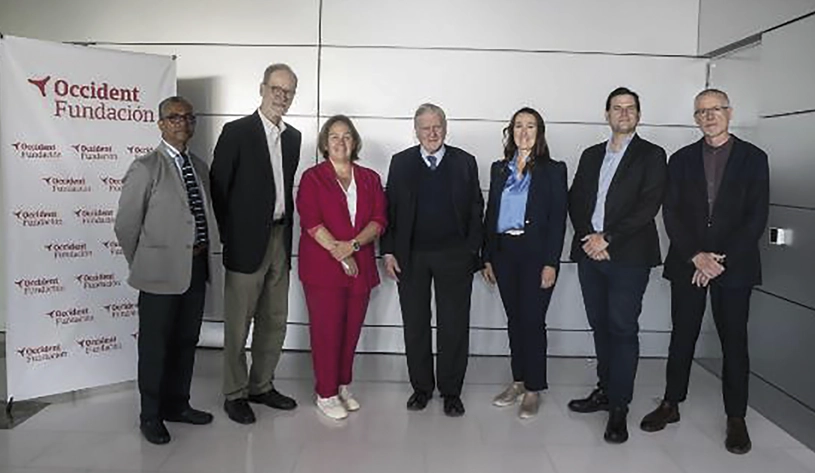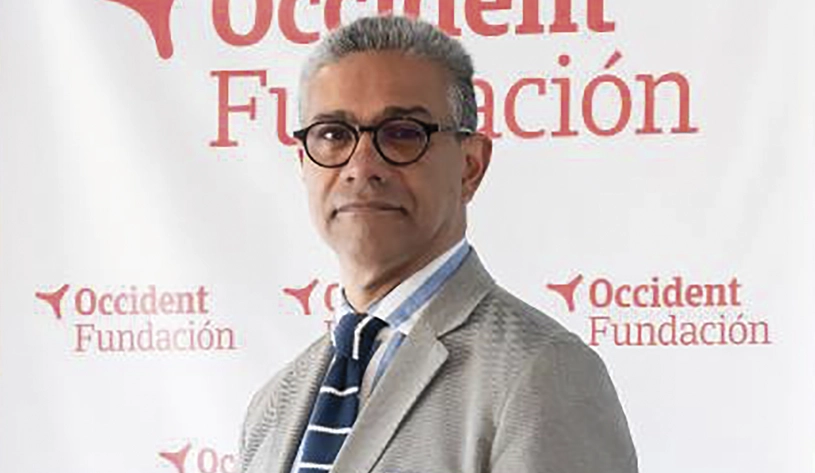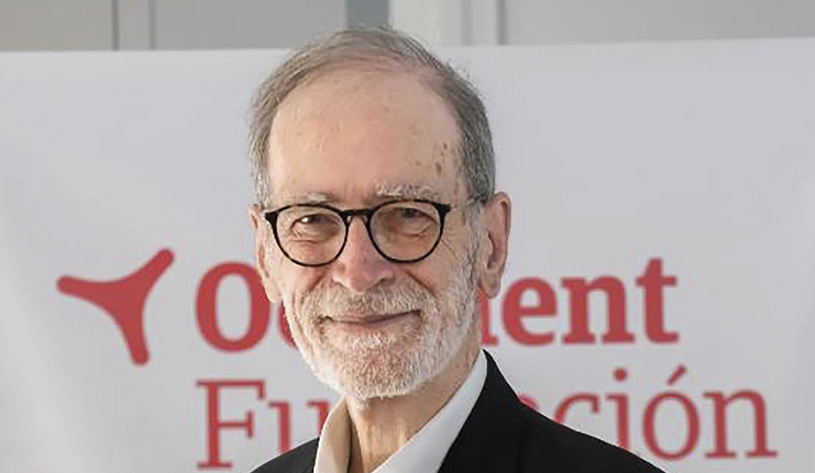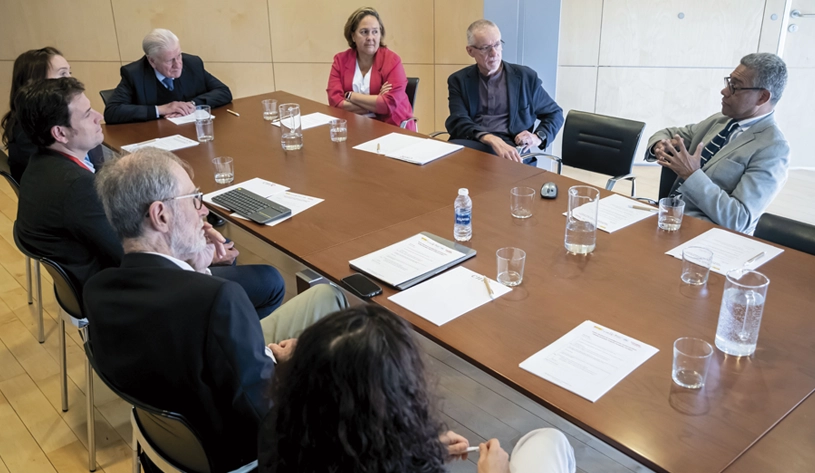CNIC and Fundación Occident host a visiting researchers programme Scientific Symposium

The Visiting Researchers programme began in 2008 and enjoys great recognition in the area of scientific research thanks to the work undertaken by the Fundación Occident and the support offered by institutions and organizations to enable progress in the programmes being worked on.
Fundación Occident and CNIC hosted a scientific symposium for the presentation of the preliminary outcomes of Dr Mark Hlatky and Dr Carlos Morillo, the two researchers participating in Fundación Occident’s Visiting Researchers Programme. The programme has cemented the scientific relationship between the two organizations, as well as attracting the presence of internationally prestigious researchers to CNIC.
On this occasion, Fundación Occident was represented at the symposium by Laura Halpern, its vice-president, and Susana Codina, the deputy director, in addition to the two visiting researchers Dr Hlatky and Dr Morillo. Representatives of CNIC included Dr Valentín Fuster, Alberto Sanz, Dr Vicente Andrés, Antonio Ureña and Beatriz Ferreiro, in addition to Dr Hlatky’s CNIC hosts, Dr Borja Ibáñez and Dr Inés García Lunar, and Dr Morillo’s hosts Dr David Filgueiras and Dr José Jalife.
To date, eight scientists have participated in this programme at CNIC. In addition to Mark Hlatky and Carlos Morillo, Guillermo Oliver, Benedetta Izzi and Raffaele Strippoli, Sandeep V. Pandit, Stuart Pocock and Gabriel Núñez are the other scientists who have benefited from the programme.

CARLOS A. MORILLO
Calgary University
Dr Carlos A Morillo is Full Professor at the Department of Cardiovascular Sciences and Senior Clinical Researcher at the Libin Cardiovascular Institute, Calgary University
“Balance is important because someone who only knows science ultimately knows nothing.”
Dr Carlos A Morillo is Full Professor at the Department of Cardiovascular Sciences and Senior Clinical Researcher at the Libin Cardiovascular Institute, Calgary University.
His chief areas of research are related with the design of clinical studies in atrial fibrillation, syncope and treatment and management of Chagas disease. Alongside the CNIC researchers, José Jalife and David Filgueiras, they have researched new ways of treating atrial fibrillation, the most common heart rhythm disorder in the world. Dr Morillo has participated in the Fundación Occident and CNIC Visiting Researchers Programme.
How did you find out about the Fundación Occident and CNIC Visiting Researchers Programme?
Almost by chance. I was participating in a conference on atrial fibrillation, and I bumped into Dr José Jalife, who told me about the programme. The truth is that I already had the idea of taking a sabbatical year. After several years as head of the Cardiology Division at the University of Calgary, Canada, I thought the time had come. Through Dr Jalife and Dr Valentín Fuster, we made a connection and that’s how I sent an application to participate in the Visiting Researchers Programme.
What is your opinion of CNIC?
I have been in many institutions worldwide, and I can tell you that CNIC ones are the highest level. The staff are highly qualified, and I have had come into contact with very interesting people. The truth is that the facilities are unique and the best that I’ve seen. I have interacted with David Filgueiras’s group and seen an extraordinary infrastructure, particularly on the experimental side and the animal facilities, with state-of-the-art technology that vastly facilitates research.
What differences do you find between the CNIC and other institutions?
The CNIC is very well structured and organized. Here, the different sections are shared within the same centre, which increases efficiency. In many other institutions, each group has its own laboratory and doesn’t share much, which reduces efficiency. Here, integration works really well.
What can you tell us about your work in Canada?
I am at the University of Calgary, in a centre that coordinates the cardiology services for the city. It is also a research institute with different groups working on clinical and basic science. Before Calgary I was at McMaster University in the Population Health Research Institute, which is one of the institutes that generates most clinical studies. But I didn’t have the infrastructure we have here at CNIC, where there are well equipped rooms with magnetic resonance and CT machines that make work a lot easier.
What areas of cardiology do you work on?
I am an electrophysiologist, and I mainly work in three research areas: atrial fibrillation, where I design clinical studies on ablation and new anticoagulants; autonomic dysfunction, with a focus on cardio-neuroablation; and Chagas disease, researching new drugs for this heart disease, which is prevalent in Latin America. Although Chagas ins an autochthonous disease of Latin America, calculations are that in Spain, due to migration, there are around 150,000 people with the infection.
I began in basic research when I started my career in electrophysiology in 1990. I discovered the first model of atrial fibrillation and performed the first cryoablations. Based on this model, Dr Jalife made other descriptions of how to locate the circuits that produced atrial fibrillation. Afterwards, I devoted myself more to the clinical sphere, but now, I wanted to return to the roots of research and I’m at CNIC with Pepe [Jalife] and David [Filgueiras] conducting various studies. In one of them we are attempting to design an antibody that acts on a specific channel of the atrium to produce an efficient, safe antiarrhythmic agent. In the last 30 years there have been no significant developments in antiarrhythmic agents; atrial fibrillation affects 40 million people worldwide and we can’t perform ablations on all of them. We need effective drugs. Part of what I am doing with the experimental model developed at CNIC is testing these new drugs to see if we can prevent atrial fibrillation and, above all, its progression.
Clinical and basic science…
I think the way in which the development of basic sciences can translate most quickly is when one is also a clinician. Sometimes there are many things done in basic research that stay in the laboratory and almost never translate into practical clinical applications. I have always been interested in trying to bridge the gap in order to accelerate the changes and discoveries and bring them to patients.
How did your interest in Chagas come about?
I became involved in Chagas research in a very curious way: due to my interest in the autonomic nervous system. When I was at the University of Virginia, I was working as an electrophysiologist in Richmond (USA) and a researcher from Colombia contacted me, mentioning he had seen my studies. He said, “I am working on a disease called Chagas, which affects the heart and cardiac nerves.” Chagas cardiomyopathy, caused by a parasite, consumes cardiac tissue, particularly conducting tissues. This can cause arrhythmias, sudden death and dilated cardiomyopathy. It is the most frequent cause of heart failure and sudden death in Latin America.
I was in Colombia, in Bucaramanga, where there is a high incidence of the disease, and I worked on the design of studies to treat this heart disease.
At McMaster University, we designed a study called BENEFIT, the largest study on Chagas, in which we randomized 3,000 patients to receive a drug or a placebo in order to see if the drug could stop or revert the development of heart disease. Unfortunately, the study results were not entirely positive, but it did open the door to conduct other studies.
What’s more, Chagas disease has always been a “forgotten” disease: the pharmaceutical industry considers it a poor people’s disease and was never interested in developing treatments. After the study, we had contacts with other laboratories to develop new molecules, some of which have worked. I also collaborated with a group called Drugs for Neglected Diseases, a foundation based in Geneva and Brazil, to develop new drugs for disregarded diseases.
At the moment, we are conducting a study with the Novartis Foundation to use drugs that have been utilized for heart failure of ischaemic origin in order to see if they prevent heart failure in Chagas patients, if they prevent progression of the disease and sudden death.
Do you already have data?
We’ve already included 1,000 patients. Now we need a year or so of monitoring, and in all likelihood at the end of this year or the next we will be presenting our results.
This would be the first specific treatment for Chagas cardiomyopathy?
Yes. Currently there is nothing specifically for it. Conventional treatments are used, but no specific studies have ever been made of this heart disease, which accelerates much more than ischaemic heart disease or dilated cardiomyopathy. Patients with Chagas develop heart failure and die much younger, at an average age of 40 to 50 years, whereas ischaemic heart disease affects people who are 60 to 65.
Chagas has a high disease burden in Latin America. Today, estimates are that between 10 and 15 million people are at risk and don’t have a specific treatment. Chagas is endemic in Argentina, Colombia. Brazil, Venezuela (to a lesser degree), Boliva (with many cases) Peru and Central America, particularly Nicaragua, El Salvador and Mexico. Autochthonous cases have also been described in the south of the United States, in Texas.
In some way, the aim is not only to repurpose these drugs, but to see if the drugs that are used for other types of heart disease could be effective against Chagas. These drugs are no longer patent protected, which would make them accessible for health systems.
This the principle of drug repurposing or repositioning. We have used drugs that we know work for other conditions but that have never been proven effective against Chagas.
Have you thought of returning to work in Colombia?
I studied medicine in Colombia, in Bogota, and later went to Canada and studied cardiology and electrophysiology again. I returned to Colombia for 6 years with a repatriation programme for researchers of Colciencias (the then Colombian Administrative Department of Science, Technology and Innovation) a bit like the USA’s National Institute of Health. I set up a basic and clinical research group on Chagas and other diseases. Although I returned to Canada, I have always included Colombian centres in my clinical studies, and I have trained many researchers from Latin America, some of whom have returned to their countries to continue their research.
And the other thing I have done is train many people from Colombia and Latin America at McMaster and Calgary, where I trained them in research and methodology before they returned to their countries. Some have stayed in different places in the world, but many have returned to their countries to try to generate continuity in the production of science in their countries of origin.
How do you see the support for science in Colombia?
There is an interest in science and technology, although it depends on the political climate. They have managed to pass a law channelling a percentage of the royalties from petroleum and other resources to science and technology, which has been very important for the country’s development in this area.
Doctor Valentín Fuster always talks about the importance of having a critical mass.
I believe that it is a combination of factors, which means that many of us, unfortunately, have ended up abroad, some for personal reasons but many others for infrastructure-related reasons. I think most of us who are abroad have tried to pay back, to remain involved with the generation of science in their country. I think the attitude has changed and that critical mass is being created in Bogotá, Bucaramanga, Barranquilla, Cali, Medellín, let’s say in the main cities, and some large towns, where there are researchers who are doing important things in Colombia. Important contributions have been made in the field of Chagas, malaria, dengue fever and other infectious diseases. Specifically in cardiovascular diseases, several researchers have been important figures in various clinical studies that have changed the practice of cardiology worldwide. So I think that we are on the right track.
What are the current generation of scientist like?
This generation is looking for a work life balance. But I also see many dedicated young people at CNIC. I think it depends on the mentor and the example one gives. Although a balance is important, dedication is also crucial to advance in science.You come from a family of doctors. How did that influence your career?
I come from a family of doctors: my father was a physician; my grandfather was a physician, and I have three siblings who are physicians, as well as 16 first cousins who are physicians. However, my children did not want to devote themselves to medicine.
I remember one summer day, my eldest daughter said to me, “Daddy, do you think we care how many articles you have published in the New England Journal of Medicine? If I asked you how many articles a famous doctor had, would you know the answer? We don’t care about that, we want you to spend time with us, but you never have time for us.” I thought about it, and it seems to me that the new generation is looking for a balance between their career and their personal lives. But I come to the CNIC laboratory almost every day and I see young people who are here until 7 or 8 pm. It depends on your mentor, on leading by example. If young people see this, some of them will follow suit, whereas others will have different interests, which is also valid.
In terms of generations, things are changing. My father was a neurologist, and he trained at the NIH with people who had won the Nobel prize, they belonged to another generation. Balance is important because someone who only knows science ultimately knows nothing. You need to be like Renaissance men, like Da Vinci, who painted, knew music and philosophy. Bach, for instance, had 22 children, and was able to write a cantata for each day of the year.
Talking about mentoring, how did you learn to be a good mentor?
In my case, I learned from my father. My father was a neurophysiologist, he had an experimental laboratory and was also a clinician. Every Saturday three or four students would come to the house to eat, and he gave seminars where he spoke of science, but also of music and literature. That’s how he created a group of students who later became teachers. I always considered him to have an effective way of mentoring.
Not everyone is made to be a mentor. In the academic sphere, we sometimes encounter difficulties because not everyone can be a mentor or a researcher, and that’s okay. Some are excellent clinicians and don’t need to be researchers. There is a place for everyone: on a chess board a pawn can be as important as a bishop if the right moves are made. Science is not only sitting down and writing protocols; some people recruit patients for clinical studies and that is also crucial.
Mentoring begins by sitting down with young people, reviewing articles, encouraging them or following their experiments. Of one hundred, maybe ten or fifteen will be researchers. Each career is difficult and managing frustration is important. However, if you have a research structure you will also be a better clinician.
Did you want to be a scientist when you were a child?
We are five siblings, four men and one woman. The three eldest are physicians, my sister is a photographer, and my youngest brother is a photographer and film maker. When we were little, my father would take us to his laboratory, where he had cats and rabbits with electrodes, because he studied the brain, He researched the arcuate nucleus, anger and the reticular formation. I was exposed to all of that from a young age.
The atmosphere reminds me of the book “Memories of My Father” by Héctor Abad Faciolince. It wasn’t just science, but also music and literature?
Yes, my father was a very special man who instilled a love of music and literature in us. At dinner time he would say things like, “Today is Greek day.” At home we had microscopes and books, and our university classmates came to study. They had great respect for him, he was head of the physiology and pharmacology department and also faculty dean. He taught us with conversations and left books or magazines on our pillows for us to read, and months later would ask us about them.
What do you think of the Fundación Occident Visiting Researchers Programmes?
I think they are excellent. It doesn’t matter what stage of your career you are at; you always have to reinvent yourself, particularly in academic and scientific fields. For me, the programme has been like coming home to what I did 30 years ago, in the 1990s, and I love it because it is stimulating and gives me new ideas. Thanks to the Foundation and its programme for senior scientists, we have the opportunity to devote a year to things that we haven’t done for a long time to which we can still probably make significant contributions.

DR. ANDREW HLATKY
University of Stanford
Dr. Mark Hlatky: Cardiologist and Professor of Health Policy and Medicine at the University of Stanford
“We respond to emergent problems, but chronic problems like heart diseases don’t generate the same urgent response.”
Dr Mark Hlatky is a cardiologist and Professor of Health Policy and Medicine at the University of Stanford. His main fields of research are clinical trials and methods of clinical research. Dr Hlatky has participated in numerous major large multi-centre randomized clinical trials, including studies on coronary revascularization, the treatment of acute myocardial infarction, hormone therapy to prevent cardiovascular diseases in women, and the treatment of potentially fatal ventricular arrhythmias. He pioneered the compilation of data on economic results and quality of life as a part of randomized trials, which has become a standard tool for researching outcomes. He has also developed decision models to assess the effectiveness and profitability of a wide range of clinical strategies, such as the prevention of sudden cardiac death, the use of tests to guide the preventive treatment of heart diseases, etc. During his period at CNIC, alongside researchers Borja Ibáñez and Inés García, he studied the effects of pregnancy on the cardiovascular health of women.
How did you find out about the Fundación Occident and CNIC Visiting Researchers Programme?
I am Professor at the University of Stanford, and I belong to the Departments of Health Policy and Cardiovascular Medicine. My research focusses on populational clinical studies, assessing whether treatments work, who they work for and if they are worth the investment made. For many years I was associate editor of the Journal of the American College of Cardiology, first with Tony Demaria and then with Dr Valentín Fuster. I attended meetings every week with Dr Fuster and Dr Borja Ibáñez. And my area of research is related with their interests. At Stanford you can take a sabbatical to think about new ideas and meet more people. It isn’t obligatory, it is optional. I had accumulated the maximum amount of time: 12 months. And my wife said, Spain, since she has Spanish heritage, and she likes the country. I spoke to Dr Fuster and Dr Ibáñez, and they said yes that they would welcome me.
Had you participated in similar exchange programmes before?
I had taken sabbaticals in Oxford (UK), Bologna (Italy) and Copenhagen (Denmark). Meeting different people, learning new ideas and collaborating in different ways is very valuable. Dr Fuster talked to me about the Fundación Occident programme. I wrote a proposal, and they asked me what I wanted to work on. At Stanford, we are interested in learning the specific reasons why women develop heart diseases. We observed that problems like preeclampsia during pregnancy increase the risk of future heart diseases. This project involves examining the biomarkers of women with and without a history of preeclampsia in Stanford and Denmark.
And, on hearing about the PESA-CNIC-Santander project, we thought of analysing the female participants to see how factors of pregnancy affect their risk of atherosclerosis. We proposed observing complications of pregnancy and other unique reproductive risk factors in women from the PESA group.
Your work also focusses on the cost-effectiveness of treatments…
Financial assessments are not common in Europe. We assess whether the prices of drugs are in consonance with their effectiveness. A new treatment for cardiac amyloidosis, for instance, is very expensive. In the USA, I work on health policies, ensuring that drugs justify their cost. We want businesses to have incentives to develop drugs and obtain a reasonable, but not excessive, financial recompense. Part of the research has been financed with public funds. That is more a political than a scientific problem. We want better treatments, but many new treatments reach only a few people due to the high cost.
Do you think that the pandemic has taught us to work together on developing treatments?
The pandemic showed that governments and the private sector can collaborate during an emergency. However, we don’t see the same urgency for heart diseases or cancer.
Cardiovascular diseases are the first cause of death worldwide, isn’t that a pandemic?
Although it is a good message, not everyone understands it the same way. We respond to emergent problems, but chronic problems like heart diseases or death from weapons don’t generate the same urgent response.
You mention mentoring, how important is it for young societies?
Mentoring is crucial to learn, conduct research and connect with people who can help you in your career. Mentors help you understand what is good for a career and offer valuable connections. They also provide support for personal problems like how to achieve a work-life balance.
A career in research means you have to leave the environment you know. Is there a fear of returning?
I have spoken to many people at CNIC who have spent time in the USA. Training in the USA is a plus because you are a different person when you return. Leaving serves to learn new things. I myself am doing it with the Fundación Jesús Serra Visiting Researchers Programme. Going to study at other institutions and then returning is very positive. In Denmark, there is a programme where medical students go to the USA to work in laboratories with mentors, called DARE. I worked with a couple of its students, and it was a great programme because they had access to things that they would never have seen, like meetings with Silicon Valley professionals. The Danish government and foundations sponsored it because they said it was a good investment for Danish researchers. It is a great opportunity to learn and access unique experiences.
Have you seen differences between a career in research in Spain and the USA?
In Europe, there are fewer positions, especially in universities and academic centres. In the USA, it is more competitive and there is more movement; people study in one place and move to another more easily than in Europe.














